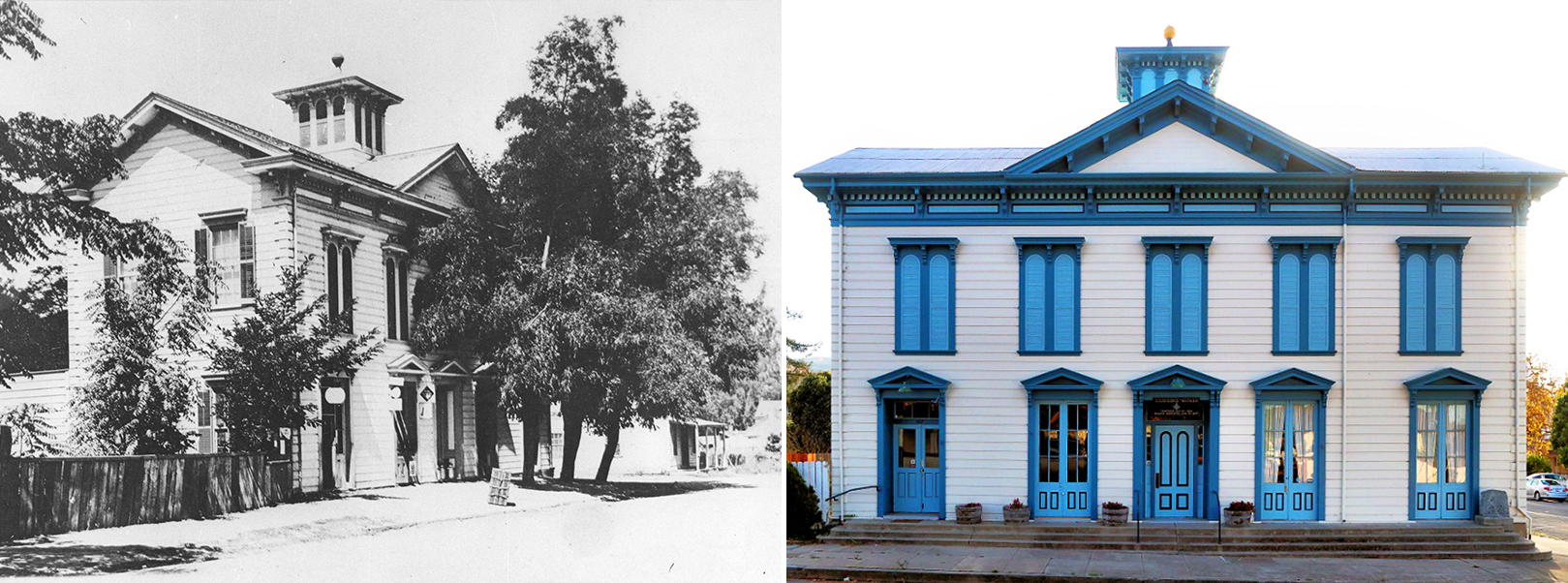Texas Masonic Lodge
The Texas Lodge Masonic Hall is one of the oldest, most iconic buildings in San Juan Bautista, andthe second oldest masonic lodge in California that is still active in its original location. The Free and Accepted Masonsis the first fraternal organization in San Juan.
Edward Farris Storey migrated to California with 42 other Texan Masons in 1852, and was granted a charter in 1854 to found a Masonic Lodge in the area of San Juan. By the end of 1854, according to Lodge minutes, membership was 20. The Masons met in various places until the National Hotel (located where Verutti Park is now) was built in 1858, and a room was made available for their meetings. Membership had grown to 110 by 1867 when they decided to build their own building. A wooden sign above the Texas Lodge Masonic Hall entrance reads “Texas Lodge #46 F&AM Chartered May 6, 1854, Building Completed, June 24, 1869.”
The upper floor of the building has continued to be used as the meeting hall of the Masons, and the lower floor was originally rented to doctors and other professionals. The large main room downstairs has served in a variety of capacities over the years. It was used for the Wells Fargo Express Office, the Justice of the Peace Office, the meeting space for monthly City Council meetings around the turn of the 19th century; then the telephone company used the space from 1901-1924; the U.S. Post Office was then housed in the space, followed by the San Juan library until 1979. Most recently, the downstairs rooms have been rented to businesses .
This rectangular two and a half story building is constructed in the Italianate Victorian style with a wood-framed structural system on a concrete foundation. The façade is symmetrical and has a 3-step stairway leading to a central recessed entrance flanked by 4 symmetrically placed 8-pane vertical window doors with triangular pediment moldings above.
The second story has 5 vertical paired arched windows with elaborate molded pediments above. The overhanging boxed cornice features scroll corbels and decorated parapet. A recessed central gable pediment tops the cornice and denotes the main entrance, and the front door swings both inward and outward. A rectangular tower with a low overhanging hipped roof and tall arched windows rises from the junction of the central gable and the medium pitched, side-gabled roof made of corrugated metal. The sides feature symmetrically placed 6-pane sash windows with molded cornice and a broken pediment on the lower cornice of the roof gable. Other notable features are quoined wood corners imitating stone, the framed semi-circular air vents within the side pediments, and the horizontal redwood shiplap siding throughout. One-story medium-gabled roof additions extend from the rear; an iron fire escape on the east side and a wooden fire escape on the west were also added. The original board sidewalk along the full width of the building was replaced with a gravel walk, which was then transitioned to concrete steps. In 2017 the building underwent a much-needed, extensive renovation and exterior painting.
Freemasonry describes itself as a “beautiful system of morality, veiled in allegory and illustrated by symbols.”Accordingly, buildings are to be constructed in an east/west orientation (sunrise and sunset), representing Solomon’s Temple. This building adorns gold enhancement of the starburst pattern framed within the side gables and the gold ball atop the cupola, depicts the sun at meridian height. Symbols and rituals abound in the upstairs meeting room: the compass and the square, which is the most widely known symbol of Masonry, the all-seeing eye, and the letter G, symbolizing both geometry and God. Masons use metaphors from geometry and the architecture of stonemasonry to represent their ongoing pursuit of knowledge, ethics, and leadership skills.
Supported By 24x7 WP Support Desk
